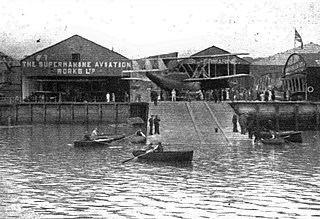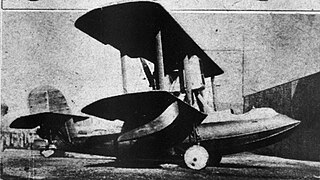
Supermarine was a British aircraft manufacturer. It is most famous for producing the Spitfire fighter plane during World War II. It also built a range of seaplanes and flying boats, winning the Schneider Trophy for seaplanes with three wins in a row in 1927, 1929 and 1931. After the war, the company produced a series of jet fighters.

Reginald Joseph Mitchell was a British aircraft designer who worked for the Southampton aviation company Supermarine from 1916 until 1936. He is best known for designing racing seaplanes such as the Supermarine S.6B, and for leading the team that designed the Supermarine Spitfire.

The Supermarine Stranraer is a flying boat designed and built by the British Supermarine Aviation Works company at Woolston, Southampton. It was developed during the 1930s on behalf of its principal operator, the Royal Air Force (RAF). It was the RAF's last and fastest biplane flying boat.

The Supermarine Southampton was a flying boat of the interwar period designed and produced by the British aircraft manufacturer Supermarine. It was one of the most successful flying boats of the era.

The Supermarine Seagull was a flying boat produced by the British aircraft manufacturer Supermarine. It was developed by Supermarine's chief designer R.J. Mitchell from the experimental Supermarine Seal II.

The Supermarine S.4 was a 1920s British single-engined monoplane built by the company Supermarine. Designed by a team led by the company's chief designer, R. J. Mitchell, it was designed to compete in the 1925 Schneider Trophy contest.

The Supermarine Seamew was a British twin engined amphibious aircraft built by Supermarine at their works in Woolston, Southampton. It was intended as a small, shipborne reconnaissance aircraft. It was designed in 1925–1927 by R. J. Mitchell to meet the Air Ministry's specification 29/24. It was the first aeroplane built by Supermarine to incorporate metal in the construction; two machines were built. Mitchell planned a civilian version of the aircraft, to accommodate up to six passengers.

The Supermarine Swan was a 1920s British commercial biplane flying boat designed by R.J. Mitchell. A single machine was built by Supermarine at their works at Woolston, Southampton. The world's first twin-engine amphibian aircraft, it was the precursor to the Supermarine Southampton.

The Supermarine Sparrow was a British two-seat light biplane designed by R.J. Mitchell and built at Supermarine's works at Woolston, Southampton. It first flew on 11 September 1924. After being rebuilt in 1926 as a parasol monoplane, it was re-designated Sparrow II.

The Supermarine Sea Lion II was a British racing flying boat built by the Supermarine Aviation Works. Designed by Reginald Mitchell, the Sea Lion II was a modification of Supermarine's Sea King II. It was powered by a 450 hp (340 kW) Napier Lion engine.

The Supermarine Sea Lion III was a British racing flying boat built by the Supermarine Aviation Works. Designed by Reginald Mitchell, it was a modification of Supermarine's Supermarine Sea Lion II. It was powered by a 550 hp (410 kW) Napier Lion engine.

The Supermarine Sea Eagle was a British, passenger–carrying, amphibious flying boat. It was designed and built by the Supermarine Aviation Works for its subsidiary, the British Marine Air Navigation Co Ltd, to be used on their cross-channel route between Southampton, the Channel Islands and France.

The Supermarine Sea King was a British single-seat amphibious biplane fighter designed by Supermarine in 1919. Developed from the Supermarine Baby and the Supermarine Sea Lion I, the Sea King was a single seater biplane powered by a pusher 160 horsepower (120 kW) Beardmore engine. It first flew in early 1920 and was exhibited by Supermarine at the 1920 Olympia Show in London. The company released drawings of the aircraft's design prior to the show; what it exhibited was probably a modified Supermarine Baby.

The Supermarine Baby was a First World War fighter aircraft that was the earliest example of a single-seat flying boat fighter to be built in the United Kingdom. It was designed by Supermarine to meet a 1917 Navy Board specification which stipulated the aircraft have a speed of 95 knots, a ceiling of 20,000 feet (6,100 m), and be capable of being launched from ships at sea. When it first flew in February 1918 it was one of the smallest and fastest flying boats then in existence.

The Supermarine Air Yacht was a British luxury passenger-carrying flying boat. It was designed by Supermarine's chief designer R. J. Mitchell and built in Woolston, Southampton in 1929. It was commissioned by the brewing magnate Ernest Guinness, and was the first British flying yacht built to the order of a private owner. Only one machine was built.

The Supermarine Commercial Amphibian was a passenger-carrying flying boat. The first aircraft to be designed by Supermarine's Reginald Mitchell, it was built at the company's works at Woolston, Southampton, for an Air Ministry competition that took place during September 1920. Based on the Supermarine Channel, the Amphibian was a biplane flying boat with a single engine, a wooden hull, unequal wingspans and a 350 horsepower (260 kW) Rolls-Royce Eagle engine. The pilot sat in an open cockpit behind two passengers.

The Supermarine Nanok was a British three-engined biplane flying boat built by Supermarine. Built to meet a Royal Danish Navy requirement, the single prototype was rebuilt as a private air yacht and renamed the Supermarine Solent.

The Supermarine Seal II was a British flying boat developed by Supermarine after it secured a British Air Ministry order for a prototype three-seater fleet spotter amphibian. The prototype, which had to be capable of landing on Royal Air Force (RAF) aircraft carriers, was designed by Supermarine's R.J. Mitchell, who incorporated suggestions made after the Supermarine Commercial Amphibian achieved second place after it was entered for an Air Ministry competition in 1920.

The Supermarine Channel was a modified version of the AD Flying Boat, purchased by Supermarine from the British Air Ministry and modified for the civil market with the intention of beginning regular air flights across the English Channel. The aircraft were given airworthiness certificates in July 1919. The Mark I version, later called the Channel I, was powered with a 160 horsepower (120 kW) Beardmore engine; a variant designated as Channel II was fitted with a 240 horsepower (180 kW) Armstrong Siddeley Puma engine. Designed by Supermarine to accommodate up to four passengers, the company produced a series of interchangeable interiors that could be used at short notice, which enabled the Channel to be used as a fighter or for training purposes.

Henry Biard was a British pilot and aircraft racer. As chief test pilot for the British aircraft manufacturer Supermarine, he won the 1922 Schneider Trophy air race and briefly held the world record for the fastest speed in a seaplane.























